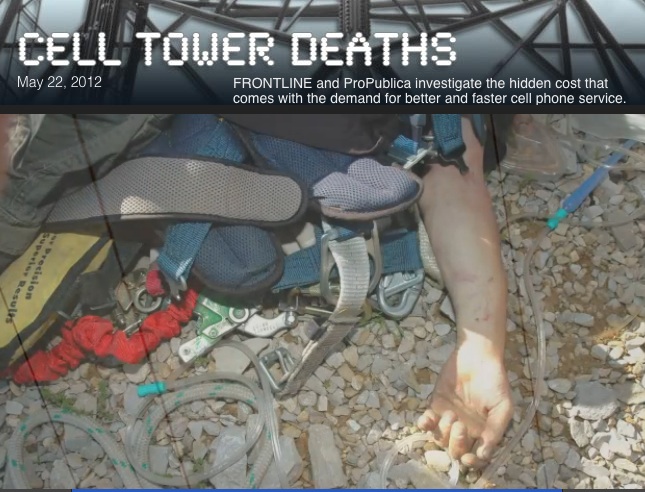

Responding to a troubling resurgence in communications tower accidents, union electrical contractors and workers this spring made communications tower safety and rescues a focus at a second Midwest location, a training center in St. Louis.
The center is jointly operated by the International Brotherhood of Electrical Workers Local 1, and the St. Louis chapter of the National Electrical Contractors Association.
IBEW and NECA had already trained 75 journey workers in cell tower safety at a training academy in Kanakee, Ill.
With towers often many miles away from first responders, the quick action of fellow workers can be a critical factor in rescues.
To earn a certification in tower climbing rescues, students in the program must complete 32 hours of training and renew the certification every two years. The training includes work on a 25-foot-tall tower on the St. Louis training center’s grounds.
“Rescuing a co-worker who has become incapacitated” is a very difficult task, said Training Center Director Dennis Gralike. “It takes a lot of skill to get an unconscious worker down hundreds of feet safely to first responders.”
In 2012, Public Television and Propublica put a spotlight on communication tower deaths, many involving workers employed by nonunion contractors and subcontractors.
The investigation revealed that as companies such as AT&T worked to rapidly expand cell tower networks to meet demand in phone use, the carriers employed program managers and layers of subcontractors to do the work. Many of the direct employers failed to properly train, equip and enforce safe behavior among a low-paid workforce, according to PBS and Propublica. Accidents followed.
Since 2013, federal safety officials have been trying harder to stop the accidents and limit hazards involved in climbs of from 100 to more than 1,000 feet. In February, 2014, the U.S. Occupational Safety and Health Administration warned employers that a lack of appropriate fall protection or use of fall protection equipment had led to some of the accidents. Falling objects, equipment failures and structural failures also hurt workers, OSHA said. In April OSHA asked via the Federal Register for comments that could help determine how best to limit the hazards and dangers.
OSHA recorded 13 communication tower worker deaths in 2013, the highest number of deaths of industry workers since 2006.
IBEW and NECA are trying to fill the safety training gap, partly by putting deeply experienced climbers in charge of the training. Garrett Biermann, who leads the IBEW/NECA tower safety and rescue-training program, is certified in climbing and tower rescue and has climbed 400 towers in the past two years.
ENR recently discussed the drive for tower safety with Frank Jacobs, Local 1 Business Manager, Doug Martin, executive vice president of NECA’s St. Louis Chapter, and Gralike.
ENR When was the joint safety program started?
Jacobs We began considering the program here in St. Louis about two-and-a-half years ago when it became evident that there was a significant demand for cellular infrastructure work that needed to be performed safely and proficiently.
Why was it started? Who decided it was needed?
Martin In the Midwest, thousands of cell towers are going up each year or in need of maintenance. Carriers had expressed an interest in engaging IBEW/NECA contractors for cellular infrastructure upgrades in Missouri. Some of them already are experienced in cell tower work. Others have successfully completed projects that entailed scaling stacks on power plants and working from extreme heights on industrial construction such as the Holcim Cement Plant in Ste. Genevieve, Mo. We wanted to make cell tower safety and rescue training more convenient.
Who can get this training? Just IBEW journey-level workers?
Jacobs We hope to offer this training across the country. The St Louis IBEW/NECA partnership has already held training and informational seminars for code enforcement officials and management personnel for our contractors. Although the liability involved in this specialized training is a factor, we will certainly consider it based on need.
Is Garrett the sole teacher and if not, who else teaches?
Gralike In addition to Garrett, another instructor, Dustin Zimmerman, will be re-certified to teach the course as well at the end of this month.
Why is there such a high number of worker deaths associated with tower work? Lack of training? Lack of oversight? More tower construction and maintenance? Something else?
Gralike We’ve not studied the incidence of fatalities. Climbing a tower is rigorous work. You need to be physically fit and well-trained on all aspects of safety…our program covers proper rigging of lanyards and harnesses, safety rules for climbers, working as a team to ensure a safe climb, stabilizing an injured worker and rescue techniques…our level of technical skill will be an asset in completing projects more efficiently, thus reducing the “time on the tower,” which should in turn reduce the risk of falls.
Why doesn’t the joint training program seek to teach first responders, too?
Jacobs We are considering it because it will be important to have the people on the ground well-trained in rescue. The big challenge is that cell towers tend to be in remote locations and in any rescue, you don’t have a lot of time to get an incapacitated co-worker down to the ground. That’s why we are training our members to ascend and descend as a team of two rescue-certified cell tower climbers, so at least one can be in a position to quickly rescue a co-worker rather than wait for first responders to get to the scene and have to make an arduous climb.



Post a comment to this article
Report Abusive Comment